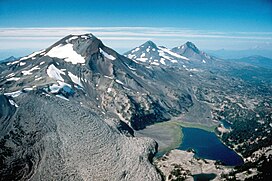| Three Sisters | |
|---|---|
 The Three Sisters, looking north | |
| Highest point | |
| Elevation | |
| Prominence | 5,588 feet (1,703 m) (South Sister)[6] |
| Listing | US most prominent peaks, 85th (South Sister) |
| Coordinates | 44°06′12″N 121°46′09″W / 44.103449°N 121.7692058°W[7] |
| Geography | |
| Location | Lane and Deschutes counties, Oregon, U.S. |
| Parent range | Cascade Range |
| Topo map(s) | USGS South Sister and North Sister |
| Geology | |
| Rock age | Quaternary |
| Mountain type(s) | Two stratovolcanoes (South, Middle) and one shield volcano (North) |
| Volcanic arc | Cascade Volcanic Arc |
| Last eruption | 440 CE[8] |
| Climbing | |
| Easiest route | Hiking or scrambling, plus glacier travel on some routes[9] |
The Three Sisters are closely spaced volcanic peaks in the U.S. state of Oregon. They are part of the Cascade Volcanic Arc, a segment of the Cascade Range in western North America extending from southern British Columbia through Washington and Oregon to Northern California. Each over 10,000 feet (3,000 meters) in elevation, they are the third-, fourth- and fifth-highest peaks in Oregon. Located in the Three Sisters Wilderness at the boundary of Lane and Deschutes counties and the Willamette and Deschutes national forests, they are about 10 miles (16 kilometers) south of the nearest town, Sisters. Diverse species of flora and fauna inhabit the area, which is subject to frequent snowfall, occasional rain, and extreme temperature variation between seasons. The mountains, particularly South Sister, are popular destinations for climbing and scrambling.
Although they are often grouped together as one unit, the three mountains have their own individual geology and eruptive history. Neither North Sister nor Middle Sister has erupted in the last 14,000 years, and it is considered unlikely that either will ever erupt again. South Sister last erupted about 2,000 years ago and could erupt in the future, threatening life within the region. After satellite imagery detected ground inflation near South Sister in 2001, the United States Geological Survey improved monitoring in the immediate area.
- ^ "South Sister". NGS Data Sheet. National Geodetic Survey, National Oceanic and Atmospheric Administration, United States Department of Commerce. Retrieved 2017-06-29.
- ^ "North Sister Quadrangle". USGS. Retrieved 2017-11-25.
- ^ The NGVD 29 elevation of 3,062.3 meters was converted using VERTCON to the NAVD 88 elevation of 3,063.7 meters.
- ^ "North Sister Quadrangle". USGS. Retrieved 2017-11-25.
- ^ The NGVD 29 elevation of 3,073.9 meters was converted using VERTCON to the NAVD 88 elevation of 3,075.3 meters.
- ^ Martin, Andy. "OREGON P2000s". Peaklist. Retrieved 2017-11-26.
- ^ "South Sister". Geographic Names Information System. United States Geological Survey, United States Department of the Interior. Retrieved 2017-11-24.
- ^ "Three Sisters". Global Volcanism Program. Smithsonian Institution. Retrieved 2008-04-02.
- ^ Bishop & Allen 2004, pp. 139–142.

